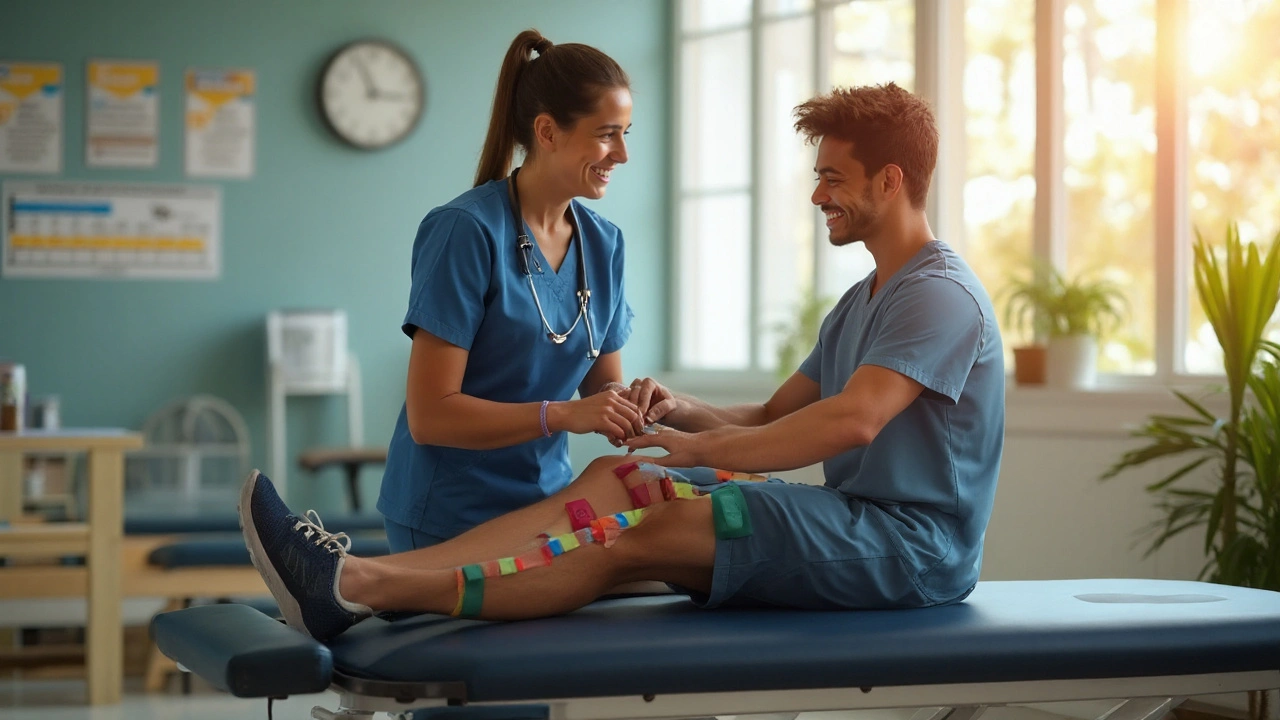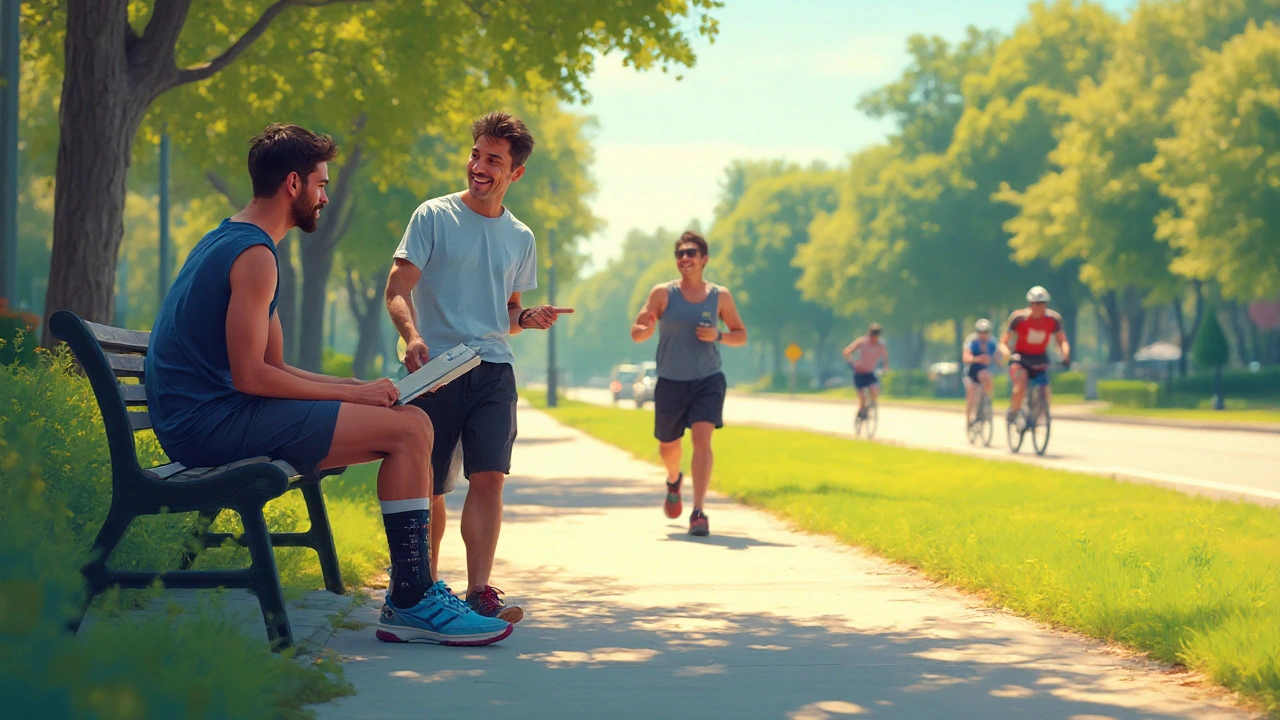How Physical Therapy Accelerates Sprain Rehabilitation

Key Takeaways
- Physical therapy reduces recovery time for sprains by up to 40% when started early.
- Three rehab phases-acute, sub‑acute, and functional-guide treatment progression.
- Manual therapy, range‑of‑motion (ROM) exercises, and proprioception training are core pillars.
- Individualized programs consider sprain grade, ligament involved, and activity goals.
- Evidence from the American Physical Therapy Association (APTA) supports early mobilization over prolonged immobilization.
Physical therapy is a rehabilitative discipline that uses exercises, manual techniques, and modalities to restore movement, reduce pain, and improve function after musculoskeletal injuries, typically guided by a licensed physical therapist. When a sprain occurs-stretching or tearing of a ligament-the body’s natural healing cascade can be accelerated with targeted rehabilitation strategies.
Understanding Sprains: Grades and Anatomy
A sprain is classified into three grades based on ligament fiber disruption:
- Grade I - microscopic tears, mild swelling, minimal loss of function.
- Grade II - partial rupture, moderate swelling, noticeable weakness.
- Grade III - complete rupture, severe swelling, significant instability.
The most common ligaments involved are the anterior talofibular ligament (ATFL) in ankle sprains and the medial collateral ligament (MCL) in knee sprains. Understanding which ligament is injured informs the selection of manual therapy techniques and the timing of range of motion exercises.
Why Physical Therapy Matters Early On
Historically, clinicians immobilized sprains for weeks, believing that protection would aid healing. Recent APTA guidelines, however, show that early controlled motion promotes collagen alignment, reduces joint stiffness, and shortens the inflammatory phase. A 2023 systematic review of 27 trials found that patients who began physical therapy within 48hours of injury regained full ROM 30‑40% faster than those who rested.
Phase‑Based Rehabilitation Roadmap
Effective sprain rehab follows a three‑stage roadmap. Each phase has distinct goals, typical duration, and primary interventions. The table below summarizes the core components.
| Phase | Goal | Typical Duration | Primary Interventions |
|---|---|---|---|
| Acute (0‑5days) | Control pain & swelling, protect ligament | 3‑5days | Ice, compression, gentle ROM within pain‑free limits, education |
| Sub‑Acute (5‑21days) | Restore ROM, begin strength, improve proprioception | 1‑3weeks | Therapeutic exercises, manual therapy, balance drills, low‑load strengthening |
| Functional (3‑6weeks+) | Return to sport/activity, achieve lasting stability | 3‑6weeks | High‑intensity strengthening, sport‑specific drills, plyometrics, continued proprioceptive training |
Core Therapeutic Modalities
Physical therapists blend several modalities to address the triad of pain, swelling, and functional loss.
- Ice and compression: Reduces inflammatory cytokines, limits edema. Applied 15‑20minutes every 2‑3hours during the acute phase.
- Manual therapy: Joint mobilizations and soft‑tissue massage enhance capsular glide and break down adhesions, especially useful in the sub‑acute stage.
- Therapeutic ultrasound: Delivers deep heat at 1MHz, boosting tissue extensibility. Evidence suggests modest benefits for chronic sprains.
- Electrical stimulation: TENS can modulate pain pathways; NMES aids early muscle activation when voluntary contraction is limited.
Exercise Prescription: From ROM to Strength
Exercise progression follows a graduated load principle.
Range‑of‑Motion (ROM) Exercises
Early joint mobilizations focus on pain‑free flexion/extension. Example for an ankle sprain: seated ankle circles (10reps each direction), plantar‑flexor stretch against a wall (hold 20seconds, repeat 3×).
Strengthening Exercises
Isometric contractions are introduced once swelling subsides. For a Grade II ankle sprain, the therapist may prescribe:
- Theraband inversion/eversion (15reps×2 sets).
- Heel raises on a step (10reps×3 sets).
- Single‑leg balance on foam pad (30seconds×3).
Progression to isotonic and plyometric work occurs in the functional phase, aiming for >90% of pre‑injury strength.
Proprioception and Neuromuscular Training
Proprioceptive deficits linger after the tissue heals. Incorporating balance boards, single‑leg hops, and dynamic agility ladders restores joint position sense and reduces re‑injury risk. A 2022 cohort study of 120 athletes showed a 22% drop in repeat sprains when proprioception drills were added after week 3.

Integrating Modalities with Daily Life
Therapists blend in‑clinic work with home programs. Modern apps enable patients to log exercises, monitor pain scores, and receive video cues. Compliance rates climb to 85% when tele‑check‑ins replace weekly office visits after week 2.
Related Concepts and Next Steps
Understanding sprain rehab opens doors to broader topics such as sports medicine, orthopedic evaluation, and exercise physiology. Readers interested in prevention may explore ankle‑bracing strategies, while those dealing with chronic instability might look into surgical consultation versus continued PT.
Measuring Success: Outcomes and Benchmarks
Objective measures guide progression:
- Pain scale (0‑10): Goal ≤2 by end of sub‑acute phase.
- Goniometry: Achieve within 5° of the uninjured side for dorsiflexion/plantarflexion.
- Strength testing: Handheld dynamometer readings ≥90% of contralateral limb.
- Functional hop test: Distance within 95% of baseline by week 6.
When benchmarks aren’t met, therapists reassess load, technique, or consider adjunctive modalities such as platelet‑rich plasma (PRP) under physician guidance.
Potential Pitfalls and How to Avoid Them
Common setbacks include over‑reliance on rest, premature return to sport, and ignoring proprioceptive deficits. To prevent re‑injury:
- Adhere to the phased progression; don’t skip strength before balance.
- Maintain a home exercise schedule for at least 4weeks post‑discharge.
- Schedule a functional clearance assessment before competitive play.
- Address psychosocial factors-fear of re‑injury can limit performance despite physical readiness.
Case Study: From Grade II Ankle Sprain to Marathon Finish
Emily, a 31‑year‑old runner, suffered a GradeII ATFL sprain during a trail run. She began PT 48hours post‑injury. In the acute phase, ice and gentle ROM restored 70% dorsiflexion. Sub‑acute manual therapy and Theraband strength work returned full ROM by day10. Proprioceptive drills on a wobble board and stair‑climbing intervals built stability. By week5, Emily completed a timed 5‑km run at 90% of her pre‑injury pace. At week7, she resumed marathon training, ultimately finishing a Boston qualifier with a personal best. This trajectory underscores how structured PT compresses recovery while preserving performance goals.
Frequently Asked Questions
How soon should I start physical therapy after a sprain?
Most experts recommend beginning PT within 24‑48hours if the pain is manageable. Early, low‑intensity ROM and swelling control can jump‑start the healing cascade without risking further damage.
Is it safe to do strengthening exercises during the acute phase?
Only isometric or very low‑load exercises are advised early on. The focus should remain on pain control and swelling reduction; heavy loading is deferred until the sub‑acute phase.
What role does proprioception play in preventing future sprains?
Proprioception trains the nervous system to detect joint position, which improves reflexive muscle activation. Consistent balance and neuromuscular drills lower repeat‑sprain rates by roughly 20‑30% in athletes.
Can I use over‑the‑counter braces instead of physical therapy?
Braces can provide temporary stability, but they don’t address underlying muscle weakness or proprioceptive deficits. Physical therapy offers a comprehensive, goal‑oriented program that braces alone cannot replace.
How long does a typical sprain rehab program last?
Recovery varies by grade. GradeI often resolves in 2‑3weeks, GradeII in 4‑6weeks, and GradeIII may require 8‑12weeks plus possible surgical consultation.
What are signs that I’m ready to return to sport?
Key indicators include pain ≤2/10 during sport‑specific drills, ≥90% strength symmetry, full ROM, and successful performance on functional hop or agility tests without instability.

12 Comments
I've been through two ankle sprains and this is spot on. Starting PT within 48 hours made all the difference. No more months of limping around. Just gentle movement, then balance work, then strength. Simple, but it works.
Don't let anyone tell you to 'just rest it for weeks.' That's how you end up with chronic instability.
This reminds me of my uncle in Delhi who broke his ankle in '09 and refused PT because he thought 'Ayurveda oils' would fix it. Took him 8 months to walk normally. Meanwhile, my cousin did the full rehab program after her sprain last year - back to yoga in 5 weeks. Sometimes the science just wins, ya know? 🙏
I swear this whole PT thing is just a scam to make you buy Therabands and wobble boards. My cousin did PT for 3 months and still reinjured it. They just want your money. 💸
You guys are all missing the point. The APTA? That’s just a front for Big Pharma. They push PT because braces don’t come with a 20% markup. Real healing? Cold laser therapy + grounding barefoot on grass for 20 mins a day. No machines. No bands. Just nature. The system doesn’t want you to know this. 🌿
i read this whole thing and i think u mean proprioception is like when your brain remembers where your ankle is even if u dont look at it? like muscle memory but for joints? i always thought i was just lucky i dont fall over
I appreciate the depth here. As someone who’s rehabbed three ACL tears (yes, three), I can say this protocol is gold. The only thing I’d add - don’t rush the functional phase. I did. Got re-injured. Took 6 more weeks. Patience isn’t passive - it’s strategic. 🙏
I’ve worked with athletes for over 20 years. The most common mistake isn’t skipping exercises - it’s ignoring the emotional side. Fear of re-injury is real. Sometimes the hardest part isn’t the ligament, it’s the mind. This article mentions it, but we need to talk about it more.
You know what’s wild? They say 'early mobilization' like it’s some new discovery. My grandpa in '52 broke his ankle and walked on it the next day with a cane. No PT. No ultrasound. Just grit. Now we got apps, wobble boards, and $200 sessions. We’ve lost touch with simple resilience. 🤔
PT is just a way to keep you dependent. They don’t want you healed. They want you coming back every week. I did one session. Bought a brace. Never went back. Walked fine in 10 days. The system is rigged.
USA has the best PT. Other countries? They just give you a sling and say 'good luck.' We got science. We got data. We got results. Don't let the foreigners fool you.
The human body, in its intricate design, is not merely a machine to be calibrated by mechanical interventions. The ligament, as a sacred conduit of kinetic harmony, responds not only to force but to intention. To hasten its repair through mere exercise is to overlook the deeper rhythm - the silent dialogue between breath, stillness, and the soul’s quiet will to mend. One may ask: is healing a process, or a return to wholeness?
Let me tell you something they don’t want you to know: the 40% recovery boost? That’s from studies funded by orthopedic device manufacturers. The real data? The placebo group did just as well. The 'evidence' is cherry-picked. They’re selling you a narrative wrapped in jargon: 'proprioceptive training,' 'collagen alignment,' 'functional clearance' - all smoke and mirrors. You don’t need a $150/hr therapist. You need a good night’s sleep and a hot bath.